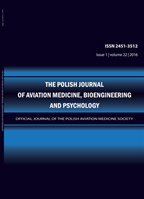2019, Volume 25, Issue 3
ASSESSMENT OF THE NUTRITIONAL STATUS OF CANDIDATES TO THE AVIATION HIGH SCHOOL IN DĘBLIN
AGATA GAŹDZIŃSKA1, MARTA TURCZYŃSKA1, PAWEŁ JAGIELSKI2
-------------------------------------------------------------------------------------------------
1Laboratory of Dietetics and Obesity Treatment, Department of Psychophysiological Measurements and Human Factor Research, Military Institute of Aviation Medicine
2Department of Nutrition and Drug Research, Faculty of Health Science, Jagiellonian University, Medical College
Autor korenspondencyjny: AGATA GAŹDZIŃSKA; Laboratory of Dietetics and Obesity Treatment, Department of Psychophysiological Measurements and Human Factor Research, Military Institute of Aviation Medicine; email: agazdzinska@wiml.waw.pl
Full text
Streszczenie
Introduction: The aim of the study was to assess the nutritional status of candidates to the General Aviation High School in Dęblin using selected anthropometric indices and bioelectrical impedance analysis.
Methods: A total of 103 candidates to the General Aviation High School in Dęblin (88 boys and 15 girls) participated in the study. The mean age of the participants was 14.7±0.46 years. The nutritional status was assessed based on measurements of body weight, body height, and calculated BMI. The results were interpreted using growth charts. The body composition was determined by means of the bioelectrical impedance method.
Results: Mean BMI of the girls was 20.6±3.0 kg/m2 (16.3 to 26.2 kg/m2) and of the boys 20.1±2.5 kg/m2 (14.4 to 27.8 kg/m2). Most of the examined adolescents (73.3% of girls and 75% of boys) had normal body weight. There were no significant differences in nutritional status in relation to the gender of the participants. 3.4% of the boys were found to be underweight. None of the girls showed features of malnutrition. Overweight, according to BMI, was diagnosed in 13.3% of the girls and 10.2% of the boys, obesity in 6.7% of the girls and 1.1% of the boys. Too low body fat percentage was observed in almost half of the boys examined.
Conclusions: The majority of the General Aviation High School candidates examined were of normal body weight. No significant differences were noted between the nutritional status and the gender of the participants, based on BMI. Overweight and obesity diagnosed on the basis of body fat percentage was significantly more frequent in the group of girls. There is a need to educate youth about the health consequences of abnormal body weight, both underweight and overweight.
Słowa kluczowe
nutritional status, BMI, children, aviation high school candidates, obesity
